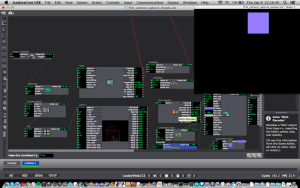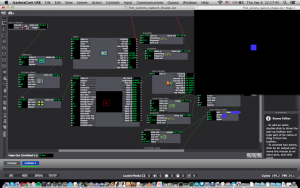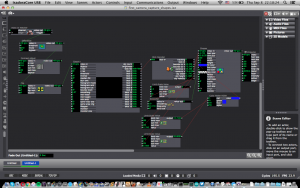Human perception. Virtual Reality. The resolution of your brain. Please watch half of this video!
Posted: September 17, 2016 Filed under: Uncategorized Leave a comment »So, this week – instead of a reading on the subject – please watch the second half of this video:
https://www.youtube.com/watch?v=UDu-cnXI8E8&ab_channel=RuthalasMenovich
(This channel has some fun stuff on it as well.)
At the very least – watch the second curly haired presenter. He tarts around 42 minutes. Use full screen to take advantage of the illusions.
For bonus points: watch the whole thing and be ready to talk about FB vision for VR.
Bonus Readings:
Just remember to breath: http://digg.com/video/augmented-reality-future
“The basic effect of the virtual reality world is to simulate the neurological conditions that might be experienced in memory and learning disorders. This insight is a good thing, as neuroscientists move closer and closer toward effective treatments for those disorders.” : http://motherboard.vice.com/read/why-the-brain-cant-make-sense-of-virtual-reality?utm_source=mbfbvn
Posted: September 15, 2016 Filed under: Uncategorized Leave a comment »
My pressure project began very ambitiously. The idea was to use the Webcam, the Eyes++ Actor and Isadora’s sound recognition actors to have users interact with the scene to the beat of the music. However, my PC’s webcam would often misbehave and the system would lag as I attempted to run all of these actors in conjunction, especially when I attempted to incorporate chroma key-based tracking and interactions. The focus of the idea was heavier on sound rather than webcam interactions, thus I scrapped the webcam element and made the process interact with the sound and only sound.
Interestingly, the reaction to the project in action during class lead to my peers wishing me to turn the music off, so they could interact with the scene using their own voices and claps of the hand. It was an unexpected outcome, indeed.
The Things #1
Posted: September 15, 2016 Filed under: Uncategorized Leave a comment »First
That thing I was talking about in class.
related to that Currents International New Media is an awesome place to intern, like i did this summer, and also to present work. It is small but truly a one of a kind place.
Second
Get tickets to Driscoll and 3 Acts 2 Dancers 1 Radio Host.
The Fly
Posted: September 15, 2016 Filed under: Pressure Project I, Robin Ediger-Seto, Uncategorized Leave a comment »This is Fly
Make sure your camera is on.
Try clapping at it.
https://www.dropbox.com/s/rx077164kz1ikai/fly.izz?dl=0
I had no clue what I was going with this, to the point that I was frustrated, and then I realized that this frustration could be one of my resources. One of the more frustrating things in this world are flies. Inspired by these creatures and the need to use the Eyes ++ actor I created a Digital fly the moves when you move and then rest on the last thing that moved, presumably you. I am not a computer programmer and the logic to make this work took most of my time. They need to use The jump actor forced me consider how to progress the story. As flies of the most annoying thing in the world (maybe slight hyperbole) the most satisfying thing (again hyperbole) is to get them. I integrated a system whereby the scene would jump when movement is detected around the fly and a sound is as loud as a clap is heard. To capture to frustration created by a fly I made it so that ones you killed it more would show up. Well doing this I made a scene in which a fly would just fly around. The previous scene jumps to at one time and I decided it was fly heaven and get back to it you have to apologize. I worked up kinks and counter actors as well as made it one more pretty and here is Fly.
Once I finish this assignment I wondered if it was generative. I came to the conclusion is not completely generative. They are fairly basic set outcomes however how you get there is different. The user has a score but what they do can differ. Also, the aspects of the fly are completely randomized including movement and color.
MuBu (Gesture Follower for Sound/Motion Data)
Posted: September 13, 2016 Filed under: Uncategorized Leave a comment »Hello all,
Here is a link to the audio/gesture recognition software I mentioned in class today. These are external objects for Max/MSP. If you don’t have a license for Max, you should be able to open the help patches in Max Runtime or an unlicensed version of Max/MSP (similar to Isadora, you’ll be able to use it but not able to save).
I found out that there is a version for Windows, but it’s not listed under the downloads; once you navigate to downloads, you’ll need to view the archives for MuBu and download version 1.9.0 instead of 1.9.1. I’ve never used it on Windows so I’m not sure how well it works, but I thought this could be of use to someone.
http://forumnet.ircam.fr/product/mubu-en/
Cirque du Soleli Media Workshop
Posted: September 13, 2016 Filed under: Uncategorized Leave a comment »Hello everyone, here’s a link to the Cirque du Soleli Media workshop I mentioned in class today: http://www.capital.edu/cirque/
SOLAR
Posted: September 13, 2016 Filed under: Uncategorized Leave a comment »Imagine entering a machine, supplying the co-ordinates of a city and a specific moment in time and as a response you receive the direction, the intensity and the sensation of heat and light that the sun radiated in that time-space.
This is a piece I saw in Ars Electronica, I hope you guys find it useful for your projects.
Axel
First Video Tracking Demo
Posted: September 8, 2016 Filed under: Uncategorized Leave a comment »Here are some screenshots from my first attempts at controlling a shape using the eyes++ actor from in class today. A blob is tracked, and its vertical and horizontal centers determine the horizontal and vertical position of the square. The object width and height are used to control the red and green color values of the square, and the object velocity is used to control the line size of the square.


Danny Coyle’s game project: Green Hill Paradise – Act 2
Posted: September 8, 2016 Filed under: Uncategorized 1 Comment »This is a video game/research project of my own design inspired by the Sonic the Hedgehog game series.
——————————–
Green Hill Paradise was born out of a question. A question that has all but torn the Sonic the Hedgehog community asunder:
Can a Sonic the Hedgehog game be made such that it supplies a rich and robust experience in a fully 3D environment while staying true to its platforming roots?
We are here to answer this question, not through an in-depth analysis video, not through a lengthy forum post, but through a fully playable video game experience. After 10 months of research and development we believe that, yes, Sonic can not only exist in 3D, but he can THRIVE in it. GHP’s massive environment, winding paths, dynamic physics and hidden collectibles provide players with the freedom to choose where they want to go and how they wish to get there. The only limitations are the laws of physics and the player’s own skill.
No Spline paths.
No Boostpads.
No scripted cameras.
No Boost Button.
Gotta Go Fast?
Earn it.
——————————–
Since the game’s release, it has been featured on various websites and YouTube “Let’s Play” videos. I figured it was prudent to share it here with you all as well. If you have any questions about the project, just ask!
Sept 8th 2016 – Pressure Project 1
Posted: September 8, 2016 Filed under: Uncategorized Leave a comment »Pressure Project #1: Generator
Time limit: 5 hours max!
Specific resources needed for this project: Isadora; and the Shapes Actor and Jump++ Actor within.
Required Achievements:
Consider: Conway’s Game of Life
http://www.youtube.com/watch?v=C2vgICfQawE
Further Consider Cellular Automata: https://www.google.com/#q=cellular+automata
Primary goal:
Create a generative patch in the Isadora programming environment that integrates the use of the Shapes Actor, Jump++ Actor, Eyes or Eyes ++ and ANY other actor(s) that you choose to develop a self-generating patch.
After initializing the patch (“pressing a button”) the patch runs it self through a visual sequence of movement and behavior.
Secondary goal: Maximize the amount of time it takes for the novice viewer of the patch to grok the patch’s behavior. (Grok: http://en.wikipedia.org/wiki/Grok)
Other Isadora Actors of note for this project: All of the actors under the Calculation heading. But specifically: Random, Wave Generator, Smoother, Curvature, Comparator, Counter, Scale Value, Calculator, Logical Calculator, Inside Range, Hold Range,
This Project is: Pass / Fail | Artistic visions/considerations are highly valued.
For further information:
- Getting started: Complete the first 7 Isadora tutorials available at the following link:
- http://www.youtube.com/watch?v=VqNw_4AWvvA
- short version of url: http://goo.gl/Z1sPlQ
- (This link is to the first tutorial. The following tutorials can be found in the associated links that pop up on the right of the YouTube interface.)